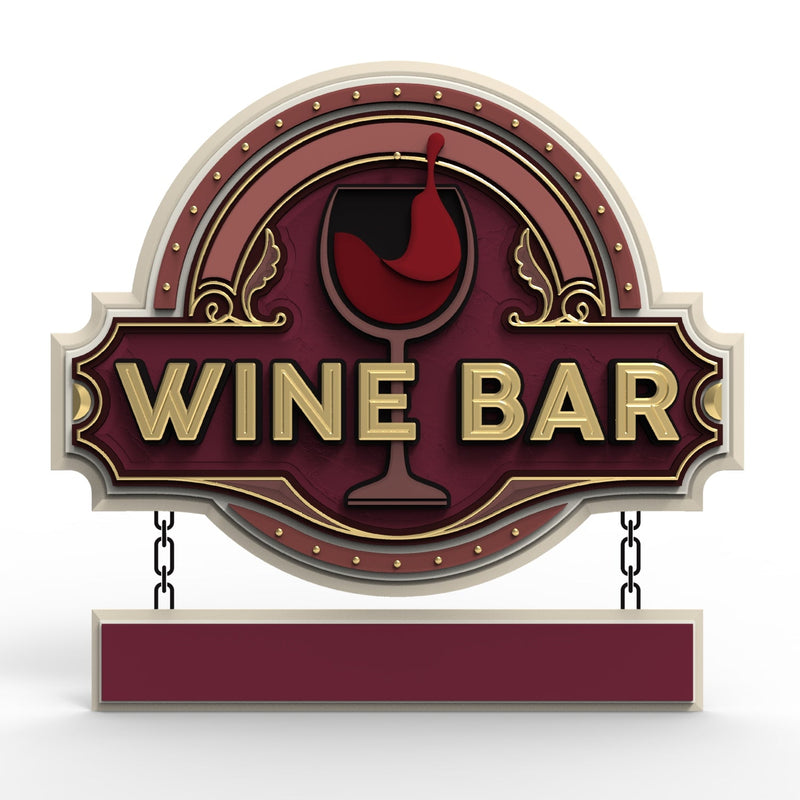Introduction
A wine bar’s charm is not only defined by its selection of vintages and the quality of its service but also by the atmosphere it presents before a guest even steps through the door. The first impression begins with the sign. For many wine bar owners, that first touchpoint, the signage, is more than a label; it’s a statement of character and craftsmanship.
Carved signs have long been associated with refinement, artistry, and authenticity. They offer a sense of permanence and prestige that flat, printed signage often can’t replicate. Whether crafted from wood, HDU (high density urethane), or metal composites, a carved sign captures depth, texture, and shadow in ways that immediately convey sophistication.
For wine bars seeking to project a warm, inviting, and premium atmosphere, carved signage provides the perfect balance of elegance and approachability. Let’s explore why this traditional art form continues to set the gold standard for upscale hospitality venues.
Wine Bar Signage: Why Carved Signs Create a Warm, Premium Welcome
1. The Emotional Appeal of Carved Signs
The sensory experience of a wine bar is built around warmth, ambient lighting, rustic wood tones, and soft music. A carved sign naturally fits within this aesthetic. Its tactile depth and textured appearance evoke craftsmanship, aligning with the artisanal feel that wine lovers often appreciate.
A carved sign doesn’t shout for attention. Instead, it exudes quiet confidence. This subtlety creates a psychological connection where guests perceive the establishment as refined and trustworthy before they even enter. That emotional association sets the tone for a memorable experience, encouraging customers to return and recommend the venue to others.
2. Premium Branding Through Materials and Craftsmanship
When it comes to carved signage, material selection plays a defining role. Each substrate contributes to the perception of quality and longevity.
Wood: Natural wood conveys tradition and authenticity. Ideal for rustic or vintage themed wine bars, wood signs can be finished with stains or paints that accentuate the grain, giving a handcrafted feel.
HDU (High Density Urethane): A modern alternative that replicates the look of wood while resisting moisture and weathering, perfect for outdoor use. HDU maintains crisp detail in intricate designs and requires minimal upkeep.
Metal Accents: Bronze or brushed aluminum inlays can add a touch of modern luxury, ideal for upscale urban wine bars or tasting lounges.
Each carved sign is custom made, allowing the brand’s logo, typography, and color palette to integrate seamlessly. This level of personalization communicates exclusivity, a key quality for businesses that pride themselves on offering curated, premium experiences.
3. Texture, Lighting, and Ambience
A well designed carved sign interacts beautifully with light. The recessed and raised areas catch illumination in dynamic ways, producing depth and contrast that enhance visibility both day and night.
For wine bars, this visual depth pairs especially well with ambient lighting. Imagine warm LED spotlights grazing across the contours of a hand carved logo or soft wall sconces accentuating the shadowed edges of engraved lettering. The interplay between texture and light gives the space a sense of intimacy and refinement, extending the sensory experience of the bar outward to the street.
This is why carved signs are often described as “living signage.” They change subtly with the light throughout the day, bright and welcoming in daylight, then moody and sophisticated at night.
4. Durability and Timeless Value
Wine bars thrive on timeless aesthetics, and a carved sign mirrors that philosophy. Unlike printed vinyl or plastic panels that fade and peel over time, carved signs are built to last.
Outdoor carved signs, when sealed with the right protective coatings, can withstand UV rays, rain, and temperature changes without losing their sharpness or color integrity. Indoor versions can last for decades with minimal maintenance, often becoming part of the venue’s identity.
Investing in a carved sign is not just about immediate appeal, it’s about long term value. The durability ensures the brand image remains consistent year after year, which reinforces customer trust and recognition.

5. Storytelling and Character
Every carved sign tells a story. The chisel marks, the layered paints, and even the grain patterns each carry an artisan’s touch. In a world dominated by mass produced graphics, this handcrafted detail stands out as a mark of care and authenticity.
For wine bars that celebrate craftsmanship, whether through small batch vintages or locally sourced ingredients, carved signage reinforces the narrative of artistry. It aligns perfectly with a brand ethos centered on tradition, detail, and passion.
Customers often notice these subtle cues. A sign that feels handmade signals that the business itself values quality and experience, two elements that resonate deeply in the wine industry.
6. Creating Consistency Between Interior and Exterior Design
A cohesive visual experience enhances the guest journey. When the exterior signage, menu displays, and interior décor all align in tone and texture, customers perceive the establishment as thoughtfully designed.
Carved signs can be carried through multiple touchpoints:
Exterior wall signs that attract foot traffic.
Hanging blade signs for narrow streets or pedestrian areas.
Interior nameplates or wall logos that echo the brand’s look.
Directional or restroom signs that maintain aesthetic consistency.
This unified approach strengthens brand identity and enhances professionalism, transforming a simple venue into a recognizable destination.
7. The Psychological Impact of Carved Signage
Design psychology plays a key role in hospitality branding. Carved signs often employ serif fonts, textured finishes, and earthy tones, all of which subconsciously signal trust, comfort, and sophistication.
The tactile dimension also plays a part. Humans instinctively associate texture with authenticity. When something looks like it has depth, our brains register it as more “real.” This authenticity aligns perfectly with wine culture, which values origin, story, and craft.
8. Customization and Artistic Freedom
Carved signage gives designers and owners immense flexibility. From deeply engraved lettering to raised emblems, every element can be adjusted to fit the personality of the space.
Wine bars often choose designs that incorporate vineyard motifs like grapes, vines, or barrels, elegant serif or script fonts, subtle metallic leafing for a hint of opulence, and weathered finishes to evoke a classic European feel.
Unlike flat prints, carved signs bring these artistic details to life in three dimensions. The result is a distinctive piece of art that doubles as a functional brand tool.
9. Enhancing Local Appeal and Foot Traffic
A beautifully crafted carved sign is not just functional, it’s magnetic. In pedestrian friendly neighborhoods or tourist areas, it can become an architectural feature that draws people in.
Wine bars often rely on walk in customers who are exploring new spots. A warm, glowing carved sign communicates quality and ambiance instantly, encouraging people to stop and experience what’s inside.
This kind of curb appeal contributes directly to revenue. A sign that feels inviting can increase customer flow, particularly during evening hours when visibility and aesthetic mood matter most.
10. Maintenance and Longevity Tips
Maintaining a carved sign’s beauty doesn’t require excessive effort, but a few best practices keep it in top condition.
Regular Cleaning: Wipe dust and grime with a soft, damp cloth to preserve clarity.
Protective Coatings: Use UV resistant sealants or marine grade finishes for outdoor installations.
Inspection: Check for cracks or fading annually, especially if the sign faces direct sunlight.
Repainting or Touch Ups: Every few years, refresh the paint to maintain vibrancy and depth.
When properly cared for, a carved sign can last decades, serving as a long term symbol of brand integrity.
FAQs (Frequently Asked Questions)
Q1: Are carved signs suitable for outdoor wine bars?
Yes. Carved signs made from durable materials like HDU or properly sealed hardwood can withstand outdoor conditions such as rain, UV exposure, and humidity. Many wine bars in coastal or urban environments use them effectively for exterior branding.
Q2: How long does a carved sign typically last?
With professional installation and periodic maintenance, a carved sign can easily last 10 to 20 years or longer. HDU signs, in particular, resist rot and warping, maintaining their details far better than traditional wood alone.
Q3: Can I incorporate my existing logo into a carved sign design?
Absolutely. Carved signs are custom made, so your logo, brand colors, and typography can be replicated in three dimensional form. Designers can also adjust the depth or texture to highlight key visual elements.
Q4: Are carved signs more expensive than printed signs?
While the upfront cost may be higher, carved signs offer long term value through durability and minimal upkeep. They also elevate perceived brand quality, which can translate into greater customer loyalty and increased traffic.
Q5: What finishes work best for a wine bar aesthetic?
Matte finishes, deep stains, and hand painted accents are popular choices. Many wine bars combine warm wood tones with subtle gold, bronze, or cream highlights for a timeless and inviting look.
Q6: How can lighting enhance a carved wine bar sign?
Strategic lighting can transform a carved sign into a centerpiece. Wall mounted sconces, hidden LED strips, or downlights can accentuate the relief and create depth, especially at night when wine bars are most active.
Conclusion
In the competitive world of hospitality, small details define success. A wine bar’s sign is often the first and most lasting impression a customer receives, and carved signage provides a level of artistry and substance that modern alternatives can’t replicate.
From its ability to convey warmth and craftsmanship to its unmatched durability and aesthetic appeal, a carved sign is more than an identifier—it’s a reflection of the brand’s soul. For wine bar owners aiming to create a premium, welcoming atmosphere, few investments deliver a stronger return on character and visual impact.
A carved sign does more than mark your business—it tells your story with depth, elegance, and permanence. And in the intimate, experiential world of wine, that story begins at the door.
Getting high-quality 3D carved signs has never been this easy! We use only the highest quality material and paint finishes available for unmatched elegance and longevity. Check out Carved Signs and our outstanding sign collection. Just pick your style and customize it - we do the rest! Feel free to contact us online or call us at +1 (970)-455-8443.




